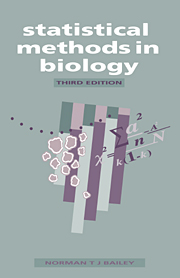Book contents
- Frontmatter
- Contents
- Preface
- 1 Introduction
- 2 Variability and frequency distributions
- 3 Estimation, standard errors and confidence limits
- 4 The basic idea of a significance test
- 5 Simple significance tests based on the normal distribution
- 6 The use of t-tests for small samples
- 7 Contingency tables and χ2
- 8 χ2-tests of goodness-of-fit and homogeneity
- 9 The correlation of measurements
- 10 Regression analysis
- 11 Simple experimental design and the analysis of variance
- 12 Introduction to factorial experiments
- 13 Random samples and random numbers
- 14 Partial correlation and multiple regression
- 15 Non-parametric and distribution-free tests
- 16 Notes on numerical calculation, calculators and computers
- Suggestions for more advanced reading
- Summary of statistical formulae
- Appendix tables
- Index
11 - Simple experimental design and the analysis of variance
Published online by Cambridge University Press: 05 June 2012
- Frontmatter
- Contents
- Preface
- 1 Introduction
- 2 Variability and frequency distributions
- 3 Estimation, standard errors and confidence limits
- 4 The basic idea of a significance test
- 5 Simple significance tests based on the normal distribution
- 6 The use of t-tests for small samples
- 7 Contingency tables and χ2
- 8 χ2-tests of goodness-of-fit and homogeneity
- 9 The correlation of measurements
- 10 Regression analysis
- 11 Simple experimental design and the analysis of variance
- 12 Introduction to factorial experiments
- 13 Random samples and random numbers
- 14 Partial correlation and multiple regression
- 15 Non-parametric and distribution-free tests
- 16 Notes on numerical calculation, calculators and computers
- Suggestions for more advanced reading
- Summary of statistical formulae
- Appendix tables
- Index
Summary
INTRODUCTION
In most of the previous chapters the main object has been to analyse scientific data so as to estimate important constants or to carry out tests of significance. The data may have arisen more or less by chance, and must be examined for signs of bias or heterogeneity. Careful sifting of the material may help to eliminate some errors of this sort, but we must guard against introducing fresh ones. In examples like that of section 5.2, where the body-weights of male and female birds were compared, we have so far assumed that the observations have been collected in such a way as to avoid unwanted bias. Sometimes, however, it is possible to exercise stricter control over the data so that these are obtained under carefully specified conditions. This leads naturally to the whole question of designing the general pattern of an experiment, partly to eliminate various disturbing effects that might creep in and partly to ensure that maximum precision is achieved for the amount of effort expended.
Some experiments, such as those whose main purpose is to determine a specific number, for example, a recombination fraction in genetics or the generation-time of a dividing bacterium, are clearly ‘absolute’ in character. Others, which are concerned with comparing the effects of different factors or treatments are of a ‘comparative’ nature. What is usually known as experimental design deals with methods of constructing and analysing these comparative experiments.
Information
- Type
- Chapter
- Information
- Statistical Methods in Biology , pp. 115 - 133Publisher: Cambridge University PressPrint publication year: 1995
